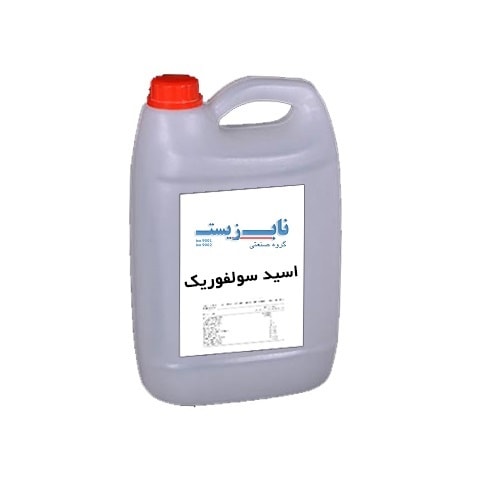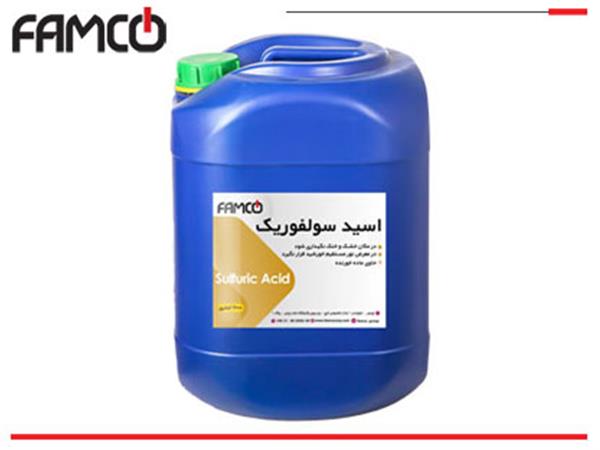
Sulfuric acid (H₂SO₄) is a highly corrosive, strong mineral acid that is colorless to slightly yellow in appearance. It is one of the most important industrial chemicals in the world, often called the "king of chemicals" due to its extensive use across various industries.
Sulfuric acid is the most widely produced chemical in the world, with annual global production exceeding 200 million tons. Its production volume is often used as an indicator of a country's industrial development and economic strength.
| Property | Value | Description | Significance |
|---|---|---|---|
| Molecular Weight | 98.079 g/mol | Mass of one mole | Stoichiometric calculations |
| Density (98%) | 1.84 g/cm³ | Mass per unit volume | Transportation planning |
| Boiling Point | 337°C | Vaporization temperature | Process design |
| pH Value | < 0 (concentrated) | Extremely acidic | Safety considerations |
Sulfuric acid has been known since ancient times, but industrial production began in the 18th century. The modern contact process, developed in 1831, revolutionized production and made sulfuric acid readily available for industrial use.
200+ million tons annually
Fertilizers, chemicals, metallurgy
Billions of dollars annually

Image: Concentrated sulfuric acid in laboratory setting
Sulfuric acid is extremely hazardous
Highly Corrosive Causes BurnsSulfuric acid has a tetrahedral molecular geometry with the sulfur atom at the center bonded to four oxygen atoms. Two of these oxygen atoms are further bonded to hydrogen atoms, making it a diprotic acid.
| Bond Type | Length (Å) | Strength | Character |
|---|---|---|---|
| S=O (double bond) | 1.43 | Very strong | Polar covalent |
| S-OH (single bond) | 1.57 | Strong | Polar covalent |
| O-H (hydroxyl) | 0.97 | Moderate | Highly polar |
Sulfuric acid is a strong diprotic acid, meaning it can donate two protons (H⁺ ions) per molecule. The first dissociation is complete in aqueous solution, while the second is nearly complete.
First dissociation: H₂SO₄ → H⁺ + HSO₄⁻ (Ka₁ = very large)
Second dissociation: HSO₄⁻ → H⁺ + SO₄²⁻ (Ka₂ = 1.2 × 10⁻²)
Always add acid to water, never water to acid. Concentrated sulfuric acid generates extreme heat when mixed with water.
| Property | Value (98% H₂SO₄) | Value (100% H₂SO₄) | Units |
|---|---|---|---|
| Density at 20°C | 1.84 | 1.827 | g/cm³ |
| Boiling Point | 338 | 337 | °C |
| Melting Point | -38 | 10 | °C |
| Viscosity at 25°C | 25.4 | 23.8 | mPa·s |
| Surface Tension | 55.0 | 56.3 | mN/m |
| Vapor Pressure at 25°C | 0.003 | 0.001 | mmHg |
The physical properties of sulfuric acid vary significantly with concentration. Commercial sulfuric acid is typically available in concentrations ranging from 78% to 98% by weight.
| Concentration (%) | Density (g/cm³) | Freezing Point (°C) | Common Use |
|---|---|---|---|
| 10 | 1.07 | -5 | Battery electrolyte |
| 78 | 1.70 | -20 | Tower acid |
| 93 | 1.82 | -32 | Industrial grade |
| 98 | 1.84 | -38 | Concentrated acid |

Image: Industrial sulfuric acid storage and handling equipment
At 98.3% concentration, sulfuric acid forms a constant-boiling mixture with water, making further concentration difficult without special techniques.
High density can cause splashing
Viscous nature affects flow rates
The contact process is the primary industrial method for producing sulfuric acid, accounting for over 95% of global production. This process involves three main steps: sulfur burning, catalytic oxidation, and absorption.
S + O₂ → SO₂ (ΔH = -297 kJ/mol)
2SO₂ + O₂ ⇌ 2SO₃ (V₂O₅ catalyst, 400-500°C)
SO₃ + H₂SO₄ → H₂S₂O₇ (oleum formation)
H₂S₂O₇ + H₂O → 2H₂SO₄
| Parameter | Typical Value | Range | Impact |
|---|---|---|---|
| Conversion Efficiency | 99.5% | 99.0-99.8% | Product yield |
| Energy Recovery | 85% | 80-90% | Economics |
| Catalyst Life | 4-8 years | 3-10 years | Maintenance cost |
| SO₂ Emissions | <0.1% | 0.05-0.2% | Environmental impact |
High temperature operations
Toxic SO₂ and SO₃ gases
| Application | Concentration Required | Volume Usage | Economic Impact | Technical Importance |
|---|---|---|---|---|
| Phosphate Fertilizers | 93-98% | Very High | Critical | Essential |
| Steel Pickling | 10-20% | High | Important | Significant |
| Chemical Synthesis | 85-98% | Medium | Moderate | Critical |
| Battery Electrolyte | 30-35% | Low | Moderate | Important |
Asia-Pacific: 65% of global consumption
North America: 15% of global consumption
Europe: 12% of global consumption
| Procedure | Requirement | Risk Level | Immediate Action |
|---|---|---|---|
| Dilution | Add acid to water slowly | Extreme | Never reverse the process |
| Spill response | Neutralize with lime/soda ash | High | Evacuate area immediately |
| Transfer operations | Use appropriate pumps/materials | High | Monitor for leaks constantly |
| Emergency shutdown | Isolate sources immediately | Critical | Activate emergency protocols |
Water (violent reaction when concentrated)
Organic materials (charring/ignition)
Metals (hydrogen gas generation)
| Material | Concentration Limit | Temperature Limit | Advantages | Limitations |
|---|---|---|---|---|
| Carbon Steel | Up to 80% | 60°C | Cost-effective, available | Corrosion at high concentrations |
| Stainless Steel 316L | Up to 95% | 100°C | Excellent corrosion resistance | Higher cost |
| Hastelloy C-276 | Up to 98% | 200°C | Superior performance | Very expensive |
| FRP (Fiberglass) | Up to 98% | 80°C | Lightweight, corrosion-resistant | Temperature sensitivity |
| Inspection Type | Frequency | Parameters Checked | Action Threshold |
|---|---|---|---|
| Visual inspection | Daily | Leaks, corrosion signs | Any visible damage |
| Wall thickness | Annual | Ultrasonic measurement | 10% reduction |
| Valve operation | Monthly | Function, sealing | Any malfunction |
| Emergency systems | Weekly | All safety equipment | Any non-compliance |
Container failure and leakage
Vapor accumulation in confined spaces
Contamination from incompatible materials
Sulfuric acid production and use can contribute to air pollution through sulfur dioxide emissions, which can lead to acid rain formation and respiratory health issues.
| Pollutant | Source | Environmental Impact | Control Method |
|---|---|---|---|
| SO₂ | Production emissions | Acid rain formation | Scrubber systems |
| SO₃ | Process leaks | Aerosol formation | Containment systems |
| H₂SO₄ mist | Storage/transfer | Local air quality | Vapor recovery |
| Particulates | Handling operations | Respiratory effects | Dust suppression |
Fines for improper disposal: $10,000-$50,000
Criminal charges possible for serious violations
| Measure | Implementation Cost | Effectiveness | Regulatory Requirement |
|---|---|---|---|
| SO₂ Scrubbing | High | 95-99% | Mandatory in most regions |
| Waste Neutralization | Medium | 90-95% | Required before discharge |
| Vapor Recovery | Medium | 85-95% | Recommended practice |
| Containment Systems | High | 98-100% | Mandatory for large facilities |
| Exposure Route | Immediate Effects | Severity | Treatment Required |
|---|---|---|---|
| Skin Contact | Severe chemical burns, tissue destruction | Critical | Immediate medical attention |
| Eye Contact | Corneal damage, permanent blindness | Critical | Emergency ophthalmology care |
| Inhalation | Respiratory irritation, pulmonary edema | Severe | Respiratory support |
| Ingestion | GI tract burns, systemic toxicity | Life-threatening | Intensive care |
Long-term exposure to sulfuric acid vapors, even at low concentrations, can lead to chronic health problems affecting multiple organ systems.
| Organization | 8-hour TWA | STEL (15 min) | Ceiling Limit |
|---|---|---|---|
| OSHA (USA) | 1 mg/m³ | - | - |
| NIOSH (USA) | 1 mg/m³ | 3 mg/m³ | - |
| ACGIH | 0.2 mg/m³ | 0.6 mg/m³ | - |
| EU (OEL) | 0.05 mg/m³ | 0.1 mg/m³ | - |
| Agency | Regulation | Scope | Key Requirements |
|---|---|---|---|
| EPA | Clean Air Act | Air emissions | SO₂ emission limits and monitoring |
| EPA | RCRA | Waste management | Hazardous waste handling and disposal |
| OSHA | 29 CFR 1910 | Workplace safety | Exposure limits and PPE requirements |
| DOT | 49 CFR | Transportation | Packaging, labeling, and shipping |
| Violation Type | Fine Range (USD) | Potential Consequences |
|---|---|---|
| Emission violations | $25,000 - $250,000 | Facility shutdown |
| Worker safety violations | $13,000 - $136,000 | Criminal charges |
| Improper disposal | $50,000 - $500,000 | Environmental remediation costs |
| Serious incidents | $1,000,000+ | Criminal prosecution |
Increased scrutiny on environmental compliance
Higher penalties for repeat violations



